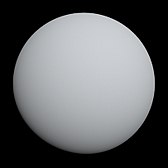CoRoT-7b
Template:Planetbox begin Template:Planetbox image Template:Planetbox star Template:Planetbox orbit Template:Planetbox character Template:Planetbox discovery Template:Planetbox catalog Template:Planetbox reference Template:Planetbox end
COROT-7b (previously named COROT-Exo-7b)[1][2] is a reported exoplanet orbiting around the star COROT-7. It was detected by the French-led COROT mission in 2009. It is the smallest exoplanet to have its diameter measured, at 1.7 times that of the Earth. The mass of COROT-7b is about 4.8 Earth masses[3]. Together with the observed radius, it is possible to exclude that the planet is made purely of iron, but other compositions, including a predominantly rocky one, are possible.[4] It orbits very close to its star with an orbital period of 20 hours. The star, in the constellation Monoceros, is 150 parsecs (490 light-years) away and is slightly smaller than the Sun.
Characteristics
| Earth | CoRoT-7b |
|---|---|

|

|
The planet has a high surface temperature, between 1000 to 1500 °C or 3,600 degrees Fahrenheit. Due to the high temperature, it may be covered in lava or water vapor.[5] The composition and density of the planet are still being examined, with one possibility being that it is rocky like Earth. It may also belong to a class of planets that are thought to be made up of water vapor and rock in almost equal amounts.[5] Theoretical work also suggest that CoRoT-7b could be a Chthonian planet (the remains of a Neptune-like planet from which much of the initial mass has been removed due to close proximity to its parent star.)[6]
The scientists are unsure whether it is an ocean planet, a kind of planet whose existence has yet to be proven so far. In theory, such planets would initially be covered partially in ice and they would later drift towards their star, with the ice melting to cover it in liquid.[5]
With an orbital period of just 20 hours, the planet has the shortest orbit ever seen in any planet, extrasolar or otherwise.[7]
According to Suzanne Aigrain, a researcher at the University of Exeter who is part of the COROT team, the planet is much more earthlike than previously found exoplanets and probably has a solid surface somewhere.[7]
Discovery
COROT-7b was found by the observation of a brightness change of its mother star, originating in a transit of the planet in front of the star (as seen from Earth). The exact knowledge of the brightness difference, together with a size estimate for the star, allows one to calculate the planet's size.
The discovery of COROT-7b was announced on 3 February 2009, during the COROT Symposium 2009 in Paris.[8] It will be published in a forthcoming special issue of the journal Astronomy and Astrophysics dedicated to results from COROT.[9]
Yahoo News also reported the planet's discovery, describing it as a "lava planet", and a confirmed rocky, earthlike body. It states that the planet is five hundred light-years away, and is referenced as "a firm place to stand outside the solar system".[10]
Confirmation status
The COROT project attempted to confirm the discovery with the HARPS spectrograph, but was unsuccessful due to reported stellar activity. However, because further attempts at confirmation were considered beyond Earth-based observations, a proposal for observation time was submitted to and accepted by the Spitzer Space Telescope program.[11][12]
See also
- COROT is an ESA space mission to discover planets using the astronomical transit method
- Spitzer Space Telescope or SST
- HARPS
References
- ^ "Notes for planet CoRoT-7 b". Retrieved 2009-03-17.
- ^
Schneider, J. (10 March 2009). "Change in CoRoT planets names". Exoplanets (Mailing list). Retrieved 2009-03-19.
{{cite mailing list}}: Unknown parameter|mailinglist=ignored (|mailing-list=suggested) (help) - ^ Cite error: The named reference
Queloz2009was invoked but never defined (see the help page). - ^ Cite error: The named reference
leger2009was invoked but never defined (see the help page). - ^ a b c "COROT discovers smallest exoplanet yet, with a surface to walk on". European Space Agency. 3 February 2009. Retrieved 2009-02-04.
- ^ "Exoplanets Exposed to the Core". Astrobiology Magazine. 25 April 2009. Retrieved 2009-07-13.
- ^ a b "Tiniest exoplanet found". Nature. 3 February 2009. Retrieved 2009-02-07.
- ^
Rouan; et al. (3 February 2009). "CoRoT-exo-7b Has CoRoT discovered the first transiting Super-Earth around a main sequence star?" (PDF). Corot Symposium – Paris. Retrieved 2009-05-13.
{{cite web}}: Explicit use of et al. in:|author=(help) - ^
University of Exeter (3 Feburary 2009). "European team finds smallest transiting extrasolar planet ever". InSciences. Retrieved 2009-02-04.
{{cite web}}: Check date values in:|date=(help) - ^ Borenstein, Seth (16 September 2009). "Found: Firm place to stand outside solar system". Yahoo! News. Retrieved 2009-09-16.
- ^ "CoRoT-Exo-7b: Confirming the first transiting rocky planet". Retrieved 2009-05-12.
- ^ "SSC Director's Discretionary Time (DDT)". Retrieved 2009-05-12.
External links
- Official website
- Schilling, Govert (3 February 2009). "COROT Finds the Smallest Exoplanet Yet". Sky & Telescope. Retrieved 2009-02-04.
- "Super-Earth found! The smallest transiting extrasolar planet ever discovered". Paris Observatory. February 2009. Retrieved 2009-02-04.
